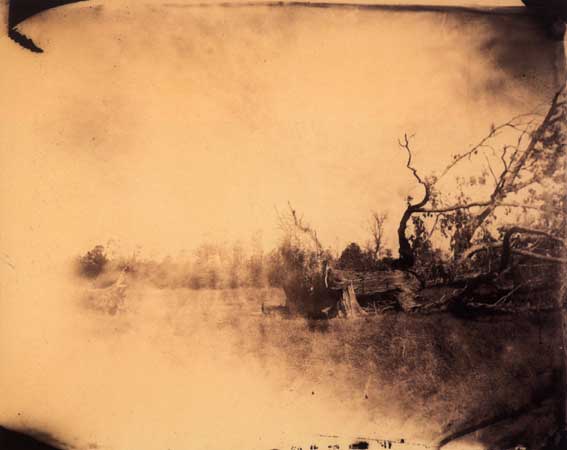 |
 |
 |
 |
 |
 |
 |
| Untitled,
from the Deep South series, (1998), silver gelatin print from collodian
glass negative, 40 x 50 inches, Sally Mann. |
Wet Collodian
Sally
Mann began to experiment with the wet
collodian
process in the 1990s to create two photographic series, Deep South
and Eva.
Mann's images have a feeling of cultivated imperfection about them due to a lens she employs in which mildew and misaligned elements contribute a sort of melancholy fog. The use of the collodian process was therefore a natural development to her work because of the interplay between clarity, dreaminess and wildness.
Deep South Series
Initially, Mann could
not apply the collodian technique effectively without some expert assistance.
She remarks, "I don't remember exactly when I made the step to collodian.
I saw a picture of an altar stone done by France Scully Osterman and it arrested
me. I tried to make them on my own, but I very quickly realized I needed help,
so I invited France and her husband, Mark, to come down to Virginia, where
I live, and do a kind of workshop with me."
Mann eventually developed her skills to a degree where she could use the collodian
process to record the landscapes of Mississippi for her series Deep South.
Her lifelong use of the 8x10 view camera and having grown up in a part of
the South rich in 19th century lore were integral to her vision for the series.
Much of the landscape in Mann's evocative work was in fact, photographed in
a similar way 150 years ago. And like the 19th century photographers before
her, who carried their darkrooms with them in a wagon, Mann drove the countryside,
living and working out of her truck. In her mobile darkroom she carried all
the glass plates and chemicals she needed to make her collodian negatives.
For Mann, nineteenth-century photography is simply unsurpassed, it has an elegance to it, a purity, that has nothing to do with naïveté. What she finds compelling about the nineteenth century is that its artists conducted a comprehensive investigation of what the camera could elicit. "They wanted to know what the camera had to do with reality," she comments. "It is not that they wanted to see what the world looked like. They wanted to see what it looked like photographed." And that is still the point of photography, as far as Mann is concerned, curiosity with the hope of revelation.